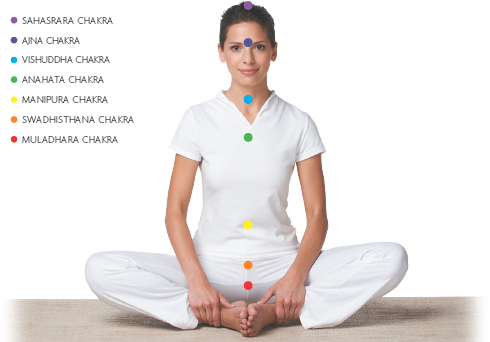

A traditional Indian depiction of the body showing some of the subtle energy channels or nadis, and the key chakras (see pages 24–5).
What powers the vital processes that bring your physical body alive, giving it the dynamism to move and breathe? What regulates your senses and the way you perceive, think and act? Ancient yoga texts tell us it is a subtle energy known as prana. This is not physical energy – prana is quite different from the electrical impulses in your nervous system – yet it flows through your body and manifests itself through your breath. By changing your breathing, you can direct this vital energy force.
The Sanskrit word prana is usually translated as “vital air”, “life-force” or “vital energy”, but none of these descriptions really explain it. We can’t translate the word into English, or any Western language, because until recently our culture lacked the concept. The Chinese word chi (as in tai chi) or the Japanese word ki (as in reiki) are exact translations. People who practise acupuncture, reflexology and most martial arts understand and work with prana. Your prana is divided into five categories each “governing” aspects of your body, mind and breath (see pages 8–9). Each main chapter of this book reveals how one of them works.
Prana flows through your body in subtle energy channels called nadis. Approximately 72,000 criss-cross your body (see image opposite) – you might like to think of them as roads on an energy highway system. The traffic on the roads is your prana. When traffic flows freely the system works well, but if a nadi becomes blocked, the flow of prana to that region of the body is reduced or even cut off. Without the nourishment of vital energy, that part of the body may weaken or become sick. For your body to be vibrantly healthy, an unimpeded flow of prana is necessary. One way to encourage this is to practise breathing exercises.
Of your 72,000 energy lines, three are of particular interest in our exploration of breathing. The ida channel flows to the left of your spine, the pingala to the right, and the central channel, which approximates your spine, is known as the sushumna. The left and right channels are associated with qualities of mind (see pages 54–7), and when your breath flows through one of these channels it develops these qualities in you. Various breathing exercises can guide your breath through the left and right channels. The only time your breath flows evenly is during meditation, when it enters the central energy channel and both sides of your brain are balanced. In order to achieve a state of meditation, ancient yogis developed breathing exercises referred to as pranayama. Practising pranayama is one of the main disciplines within hatha yoga (see page 156).
The point where two or more nadis meet forms a junction of energy known as a chakra, Sanskrit for “wheel”. You might like to visualize these whirling balls of energy as a multi-dimensional telephone exchange where numerous wires feed in and distribute vast amounts of information. The more nadis that intersect, the more likely your energy highway is to become blocked, which is why many breathing techniques aim to clear energy junctions so that prana can flow freely again.
There are seven major chakras on the sushumna, your central energy channel: around the crown of your head, around your forehead, throat, heart, solar plexus, lower abdomen and around the base of your spine. Each chakra governs a different sense, type of emotion and quality of mind and body function (see opposite). As energy passes up through the chakras in your energetic system, it becomes more rarified.

SAHASRARA CHAKRA, at the crown of your head, is where you receive the inspiration to venture beyond self-defined limitations. Focusing breathing exercises on this chakra helps you to develop a connection with the divine and enhances your sense of wonder.
AJNA CHAKRA, at the centre of your forehead, lies beyond the five elements and your senses, and is the seat of intuition and imagination. Focusing breathing exercises on this chakra enhances understanding and wisdom and helps you to develop a purpose in life.
VISHUDDHA CHAKRA, at your throat, is associated with the element space, or ether, and your sense of hearing. It is your energetic centre of communication. Focusing breathing exercises on this chakra brings about calmness and enhances communication skills.
ANAHATA CHAKRA, around your heart, is associated with the element air, your sense of touch and love. Focusing breathing exercises on this chakra helps you to develop compassion and forgiveness.
MANIPURA CHAKRA, around your solar plexus, is associated with the element fire and your sense of sight. It is your body’s power centre and the site of your digestive fire (see page 72). Focusing breathing exercises on this chakra helps you to harness willpower and realize your ambitions.
SWADHISTHANA CHAKRA, sited around your lower abdomen, is associated with the water element and your sense of taste. This chakra embodies creative energy and is the seat of your sexuality, plans and desire. Focusing breathing exercises on this chakra helps you to go with the flow and taste all that life has to offer.
MULADHARA CHAKRA, at the base of your body, is associated with the earth element and your sense of smell. This is the seat of a vast potential energy known as kundalini, said to be lying dormant, waiting to be awakened. Focusing breathing exercises on this chakra helps you to put down roots and develop steadiness of mind.